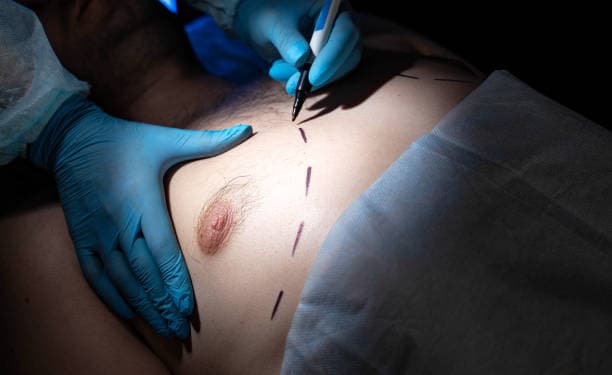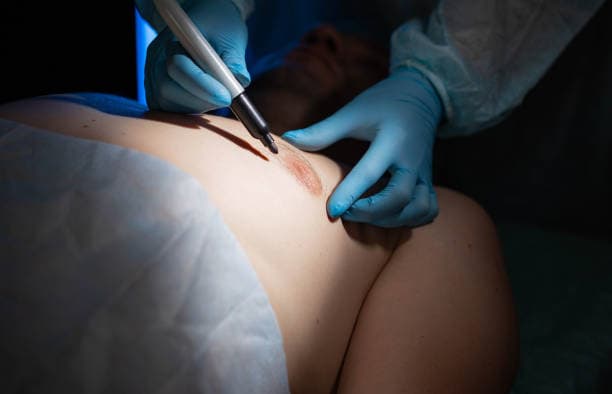While Gynecomastia can significantly improve self-confidence and body image, it's important to be aware of the potential risks and complications associated with the surgery. These risks include anesthesia complications, bleeding (hematoma), blood clots, infection, and changes in nipple or breast sensation.
Risks of gynecomastia surgery
Gynecomastia surgery, or male breast reduction, carries several potential risks and complications. Like any surgical procedure, it involves general risks such as reactions to anesthesia, bleeding, and infection. Patients may also experience changes in nipple or breast sensation, which can be temporary or permanent. There is a possibility of scarring, including hypertrophic or keloid scars, which can be noticeable and sometimes uncomfortable. In some cases, there may be asymmetry or irregularities in the contour of the chest, requiring further corrective procedures. Additionally, complications such as hematoma (blood accumulation) and seroma (fluid accumulation) can occur, necessitating medical intervention. To minimize these risks, it's crucial to choose a board-certified plastic surgeon and follow all pre- and post-operative care instructions diligently. Understanding these potential risks helps patients make informed decisions and prepare adequately for the surgery and recovery process.

Complications of gynecomastia surgery
Gynecomastia surgery, while generally safe and effective, carries potential complications that patients should consider. Among the most common complications are adverse reactions to anesthesia, which can include nausea and in rare cases, more severe reactions. Infection is a risk inherent in any surgical procedure, necessitating diligent wound care and sometimes antibiotics to manage. Changes in nipple or breast sensation are possible, ranging from temporary numbness to permanent alterations. Scarring, including hypertrophic or keloid scars, can be noticeable and occasionally uncomfortable. There may also be cosmetic concerns such as asymmetry or contour irregularities, which could require corrective procedures. Damage to deeper structures such as nerves, blood vessels, muscles, and, very rarely, the lungs can occur, leading to further complications. To minimize these risks, it is crucial to choose a board-certified plastic surgeon and adhere strictly to all pre- and post-operative care instructions.
Risk of hematoma
The risk of hematoma, which is the accumulation of blood outside of blood vessels, is a notable concern following gynecomastia surgery. Hematomas can develop when blood vessels are damaged during the surgical procedure, leading to blood pooling beneath the skin. This complication is most likely to occur within the first 24 hours after surgery, but it can happen later as well. The presence of a hematoma can cause swelling, bruising, and pain, and it may lead to noticeable discoloration and firmness in the affected area. If left untreated, a hematoma can increase the risk of infection and may compromise the results of the surgery. Management often requires surgical intervention to drain the accumulated blood and to control any ongoing bleeding. To reduce the risk of developing a hematoma, surgeons take several precautions, such as ensuring meticulous surgical technique, using drains to prevent fluid accumulation, and advising patients to avoid strenuous activities and medications that can increase bleeding risk in the immediate postoperative period. Patients are also closely monitored during the early stages of recovery for any signs of hematoma formation, allowing for prompt intervention if necessary.

Risk of Infections
Infections are a potential risk following gynecomastia surgery, as with any surgical procedure. They can occur when bacteria enter the surgical site, leading to symptoms such as redness, swelling, warmth, and pain around the incision area. Fever and chills might also indicate an infection. Proper surgical techniques, sterile environments, and post-operative care are crucial in minimizing this risk. Surgeons often prescribe antibiotics to prevent infections and advise patients on how to care for their incisions at home. It's important to follow all post-operative instructions diligently, including keeping the surgical area clean and dry, changing dressings as directed, and avoiding activities that could introduce bacteria to the wound. Despite these precautions, infections can still occur, and if untreated, they can lead to more severe complications, such as abscess formation or systemic infection. Early detection and treatment are key; if a patient suspects an infection, they should contact their surgeon immediately to receive appropriate care. In some cases, additional surgery might be required to address the infection.

Risks of nipple sensation loss
The risk of nipple sensation loss is a significant concern following gynecomastia surgery. This complication arises when the nerves supplying the nipple are damaged during the procedure, which can occur due to the removal of excess glandular tissue and fat. The extent of sensation loss can vary; some patients may experience temporary numbness that gradually improves over weeks to months, while others may face permanent changes. Factors influencing this risk include the surgeon’s technique, the amount of tissue removed, and individual variations in anatomy. Sensation loss can impact not only physical feeling but also emotional and psychological aspects, as the nipples play a role in body image and sexual sensitivity. Surgeons aim to minimize this risk by employing careful and precise surgical methods, and patients are often advised on the potential for such outcomes during pre-operative consultations. It is essential for patients to discuss their concerns with their surgeon and understand the risks involved. While some degree of sensation change is common, complete loss is rare. Proper post-operative care and following the surgeon’s guidelines can aid in the recovery process, helping to preserve as much sensation as possible.

Conclusion
While gynecomastia surgery can offer significant improvements in self-confidence and body image by reducing excess breast tissue, it is essential to be aware of the associated risks and potential complications. These include anesthesia reactions, bleeding, infection, changes in nipple sensation, scarring, and asymmetry. Understanding these risks allows patients to make informed decisions and take necessary precautions to minimize complications. Choosing a board-certified plastic surgeon and adhering to pre- and post-operative care instructions are critical steps in ensuring a safe and successful outcome.
Read More